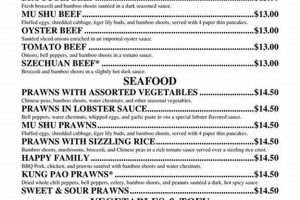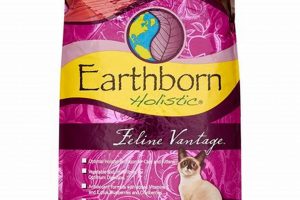Selecting optimal nutrition for this breed is a crucial aspect of responsible ownership. A diet designed to support their muscular build and high energy levels is paramount. The appropriate selection contributes significantly to their overall health and well-being.
Adequate nutrition promotes vitality, supports joint health, and helps maintain a healthy coat. Historically, understanding the specific dietary requirements of such breeds was less emphasized, but modern veterinary science provides a more informed approach to their alimentary needs, focusing on tailored nutrition.
The subsequent sections will address key considerations for selecting an appropriate dietary regime, including protein sources, carbohydrate content, fat ratios, and the inclusion of necessary vitamins and minerals. These aspects will be discussed in detail to provide a comprehensive guide for owners.
Dietary Recommendations
The following recommendations aim to provide guidance on optimizing nutrition for Staffordshire Terriers. Adherence to these principles can contribute significantly to the animal’s health and longevity.
Tip 1: Prioritize High-Quality Protein Sources: Lean meats such as chicken, turkey, and fish should form the foundation of the diet. Adequate protein intake supports muscle development and maintenance, critical for this breed.
Tip 2: Monitor Fat Intake: Healthy fats are essential for energy and coat health. However, excessive fat consumption can lead to obesity. Choose foods with a balanced ratio of omega-3 and omega-6 fatty acids.
Tip 3: Control Carbohydrate Content: While carbohydrates provide energy, excessive amounts, particularly from refined sources, can contribute to weight gain. Opt for complex carbohydrates like sweet potatoes and brown rice in moderation.
Tip 4: Incorporate Essential Vitamins and Minerals: Ensure the diet includes adequate vitamins and minerals to support overall health. Consult with a veterinarian to determine if supplementation is necessary, particularly for specific health concerns.
Tip 5: Avoid Common Allergens: Be mindful of potential allergens such as corn, wheat, and soy. If digestive issues or skin problems arise, consider switching to a limited-ingredient diet to identify and eliminate potential triggers.
Tip 6: Maintain Consistent Feeding Schedules: Establish a regular feeding schedule to promote healthy digestion and prevent overeating. Divide the daily food allowance into two or three meals.
Tip 7: Provide Fresh Water: Ensure constant access to fresh, clean water. Hydration is crucial for overall health and aids in digestion.
Implementing these recommendations can lead to improved vitality, a healthier weight, and a reduced risk of diet-related health issues in Staffordshire Terriers.
The subsequent sections will delve into specific food types and brands that align with these recommendations, providing further guidance for making informed dietary choices.
1. High-quality protein source
The selection of a high-quality protein source is a cornerstone of optimal nutrition for Staffordshire Terriers. These dogs possess a robust musculature and high energy requirements, both of which necessitate a substantial intake of amino acids derived from protein. Insufficient or low-quality protein can lead to muscle wasting, impaired immune function, and reduced overall vitality. The type of protein significantly impacts digestibility and bioavailability, influencing how effectively the dog can utilize the nutrients. For instance, a diet predominantly composed of plant-based proteins may not provide the full spectrum of essential amino acids required, necessitating careful supplementation. In contrast, animal-based proteins such as chicken, turkey, and fish offer a more complete amino acid profile, supporting muscle growth and repair more effectively.
The practical application of this understanding involves meticulous examination of food labels. Protein sources should be clearly identified, and the protein percentage should align with the dog’s activity level and life stage. Active adult Staffordshire Terriers require a higher protein percentage compared to less active senior dogs. Furthermore, the source of the protein should be evaluated; named meat sources (e.g., “chicken meal”) are generally preferable to generic terms like “meat by-products.” Real-life examples illustrate the consequences of neglecting this aspect. Staffordshire Terriers fed diets low in high-quality protein often exhibit signs of muscle loss, a dull coat, and decreased energy levels. Conversely, those fed diets rich in readily digestible animal-based proteins tend to maintain a lean physique, possess a healthy coat, and exhibit increased vigor.
In summary, the provision of a high-quality protein source is inextricably linked to the selection of optimal nutrition for Staffordshire Terriers. This choice directly influences muscle development, immune function, and overall well-being. While specific protein requirements vary depending on individual factors, prioritizing named animal-based protein sources and carefully evaluating food labels are critical steps in ensuring the nutritional needs of this breed are adequately met. This, however, presents a challenge, as cheaper dog foods often use lower-quality protein sources. Therefore, informed decision-making and, potentially, consultation with a veterinarian are crucial to overcoming this hurdle and guaranteeing optimal nutrition.
2. Appropriate calorie density
Achieving appropriate calorie density is paramount when selecting sustenance for Staffordshire Terriers. The breed’s propensity for muscle mass and active disposition necessitates a careful calibration of caloric intake to prevent both obesity and malnutrition.
- Metabolic Rate Considerations
Staffordshire Terriers, despite their muscular build, can be prone to weight gain if caloric intake exceeds expenditure. Factors such as age, activity level, and individual metabolism influence the appropriate calorie density. A sedentary senior dog requires significantly fewer calories per serving compared to a young, actively working animal. The food’s formulation must reflect these varying metabolic demands to maintain a healthy weight.
- Portion Control and Measurement
Even with a food of appropriate calorie density, diligent portion control is essential. Utilizing measuring cups and scales to accurately determine food portions is crucial. Overfeeding, even with a “healthy” food, can rapidly lead to obesity. Consistent measurement ensures that the animal receives the precise caloric intake necessary to sustain its activity level and metabolic rate, avoiding excess energy storage as fat.
- Activity Level Synchronization
Caloric density should be synchronized with the dog’s daily activity levels. Periods of increased exercise or training warrant a higher caloric intake to fuel muscle activity and recovery. Conversely, during periods of reduced activity, such as during recovery from illness or injury, caloric intake should be reduced to prevent weight gain. Failing to adjust caloric intake in response to changes in activity can disrupt the energy balance and lead to unhealthy fluctuations in weight.
- Ingredient Composition and Digestibility
The digestibility of ingredients influences the effective calorie density. Highly digestible ingredients allow the animal to extract more energy from each serving. Foods with lower-quality ingredients and poor digestibility may require larger serving sizes to meet caloric needs, potentially leading to digestive upset. Prioritizing foods with highly digestible ingredients, such as named meat sources and easily processed carbohydrates, optimizes caloric utilization and reduces the risk of gastrointestinal issues.
The careful management of caloric density is intrinsically linked to the overall suitability of a diet for Staffordshire Terriers. Overfeeding or underfeeding, regardless of the quality of individual ingredients, can have detrimental effects on the animal’s health and longevity. Therefore, an understanding of the breed’s specific caloric needs, coupled with diligent monitoring and adjustment, is essential for ensuring optimal health and well-being.
3. Balanced nutrient ratios
Optimal nutrition for Staffordshire Terriers hinges critically on maintaining balanced nutrient ratios. The breed’s physiology demands specific proportions of macronutrients (protein, fat, and carbohydrates) and micronutrients (vitamins and minerals) to support muscle mass, energy levels, and overall physiological function. An imbalance can lead to a cascade of adverse effects, ranging from stunted growth in puppies to organ dysfunction in adults. For instance, excessive calcium relative to phosphorus can disrupt bone development, while inadequate vitamin D impairs calcium absorption, leading to skeletal abnormalities.
The practical implication of this principle lies in the careful evaluation of food labels. Dog food manufacturers are required to list guaranteed analysis, indicating the minimum or maximum percentages of key nutrients. However, these values alone are insufficient. The source and bioavailability of nutrients also matter. A food with high protein content derived from low-quality sources may be less beneficial than a food with moderate protein from highly digestible ingredients. Furthermore, the ratio of omega-3 to omega-6 fatty acids is critical for inflammatory control and skin health. An imbalance favoring omega-6 fatty acids can exacerbate inflammatory conditions, contributing to skin allergies and joint problems commonly seen in the breed. Conversely, sufficient omega-3 fatty acids support a healthy coat and reduce inflammation. Real-life examples show dogs on imbalanced diets exhibit issues like poor coat quality, digestive upset, and weakened immune systems. Switching to a food with appropriate ratios can markedly improve their health.
In summary, balanced nutrient ratios are not merely desirable but essential for Staffordshire Terrier health. These proportions influence skeletal development, immune function, and overall vitality. Choosing the right food requires diligent label reading, awareness of ingredient sources, and possibly, consultation with a veterinary nutritionist to ensure dietary needs are adequately met. The challenge lies in navigating the vast array of commercially available dog foods and discerning those that truly provide balanced nutrition tailored to the breed’s specific requirements. A failure to prioritize balanced ratios can undermine even the best efforts to provide optimal care, resulting in preventable health problems.
4. Digestibility optimization
Digestibility optimization forms a cornerstone of selecting the most appropriate alimentation for Staffordshire Terriers. The breed, while robust, benefits significantly from a diet formulated to maximize nutrient absorption and minimize digestive distress. Poor digestibility leads to inefficient nutrient uptake, manifesting as symptoms ranging from soft stools to nutrient deficiencies. This inefficiency necessitates larger food volumes to meet nutritional requirements, paradoxically exacerbating digestive problems. The correlation between digestibility and well-being is demonstrable; a diet formulated with highly digestible ingredients mitigates these issues, allowing the animal to efficiently utilize available nutrients.
The attainment of optimized digestibility depends on several factors, primarily ingredient selection and processing methods. Highly digestible protein sources, such as hydrolyzed proteins or specific animal meals, undergo processing to enhance their absorbability. Carbohydrates, similarly, benefit from processing techniques that break down complex starches into simpler sugars, facilitating digestion. The inclusion of prebiotic fibers further enhances digestibility by promoting the growth of beneficial gut bacteria, contributing to a healthier digestive environment. Conversely, foods containing excessive fiber or poorly processed grains can impede digestion, leading to fermentation in the colon and resultant gastrointestinal discomfort. Real-world examples indicate that transitioning Staffordshire Terriers from low-digestibility diets to optimized formulations results in improvements in stool quality, energy levels, and overall vitality.
In summary, prioritizing digestibility optimization is indispensable when selecting sustenance for Staffordshire Terriers. A diet formulated with highly digestible ingredients facilitates efficient nutrient absorption, minimizes digestive distress, and contributes to enhanced overall health. The challenge lies in discerning formulations that prioritize digestibility through careful ingredient selection and processing methods. While marketing claims may emphasize certain aspects of nutrition, a thorough understanding of ingredient digestibility and its impact on canine physiology is essential for making informed dietary choices and ensuring the well-being of this breed.
5. Allergen avoidance
Allergen avoidance constitutes a critical element in determining the suitability of any dietary regimen for Staffordshire Terriers. This breed exhibits a predisposition to various food sensitivities and allergies, manifesting as dermatological issues, gastrointestinal disturbances, and, in severe cases, systemic reactions. Identifying and eliminating potential allergens is, therefore, not merely a preventative measure but often a necessary intervention for maintaining optimal health. The relationship between allergen exposure and adverse health outcomes is demonstrably causal; ingestion of allergenic substances triggers an immune response, leading to inflammation and tissue damage. Selecting a diet formulated with minimal common allergens is pivotal to mitigating these risks and promoting overall well-being. The inclusion of novel protein sources and exclusion of grains such as wheat, corn, and soy can reduce the likelihood of triggering an allergic response.
Practical application of allergen avoidance requires meticulous examination of food labels and diligent monitoring of the animal’s response to different dietary components. Ingredient lists should be scrutinized for the presence of common allergens, and consideration should be given to the potential for cross-contamination during manufacturing. Elimination diets, under veterinary supervision, can be instrumental in pinpointing specific allergenic triggers. This process involves feeding the animal a limited-ingredient diet with novel protein and carbohydrate sources, gradually reintroducing suspect ingredients to observe for any adverse reactions. Success in allergen avoidance translates directly into improved skin health, reduced gastrointestinal distress, and enhanced quality of life. However, implementing these measures presents challenges, as identifying subtle allergens and ensuring complete avoidance can be complex and time-consuming.
In conclusion, allergen avoidance is inextricably linked to the concept of providing sustenance for Staffordshire Terriers. The breed’s susceptibility to food sensitivities necessitates proactive dietary management, emphasizing the selection of hypoallergenic formulations and the identification and elimination of specific allergenic triggers. By prioritizing allergen avoidance, owners can significantly reduce the risk of adverse health outcomes and contribute to the long-term well-being of their animals. However, the process requires diligence, careful observation, and, in many cases, collaboration with a veterinarian to navigate the complexities of food allergies and ensure the selection of a truly suitable diet.
6. Life-stage specific formulas
The selection of optimal sustenance for Staffordshire Terriers is intrinsically linked to life-stage specific formulations. Nutritional requirements vary significantly across different phases of life, from puppyhood through adulthood and into the senior years. A failure to tailor dietary provisions to these changing needs can result in developmental deficits, compromised health, and reduced longevity. The appropriate life-stage formula addresses these fluctuating requirements, providing the precise balance of nutrients necessary to support growth, maintenance, or geriatric health. For example, a puppy formula prioritizes protein and calcium for skeletal development, while a senior formula typically reduces calories and includes joint-supportive supplements. This targeted approach is critical because nutritional excesses or deficiencies during specific life stages can have irreversible consequences.
The practical significance of understanding this connection manifests in tangible health outcomes. Staffordshire Terrier puppies fed an adult formula may experience stunted growth or skeletal abnormalities due to insufficient calcium and phosphorus. Conversely, senior dogs maintained on a high-calorie puppy formula are prone to obesity and related health complications. The choice of life-stage specific formulas necessitates careful consideration of ingredient composition, nutrient ratios, and caloric density. Commercial dog food manufacturers typically offer formulations specifically designed for puppies, adults, and senior dogs, reflecting the distinct nutritional requirements of each life stage. However, careful label reading and consultation with a veterinarian are essential to ensure that the selected formula aligns with the individual animal’s needs and health status.
In summary, the selection of sustenance is not a static decision but an ongoing process that must adapt to the changing needs of the Staffordshire Terrier throughout its lifespan. The use of life-stage specific formulas provides a targeted approach to meeting these fluctuating requirements, promoting optimal health and well-being. Challenges remain in navigating the complexities of commercial dog food formulations and accurately assessing the individual animal’s needs. Despite these challenges, the benefits of prioritizing life-stage specific nutrition far outweigh the effort, contributing to improved health outcomes and extended lifespan.
7. Veterinarian consultation
Veterinarian consultation forms a crucial link in determining the optimal sustenance for a Staffordshire Terrier. Dietary recommendations cannot be universally applied, as individual animals possess unique health profiles, activity levels, and genetic predispositions that influence nutritional requirements. Consequently, a generalized approach to feeding, devoid of expert guidance, may prove inadequate or even detrimental. A veterinarian, through physical examination, medical history review, and, if necessary, diagnostic testing, can assess the animal’s specific needs, identify underlying health concerns, and tailor dietary recommendations accordingly. This personalized approach minimizes the risk of adverse reactions, addresses existing health conditions, and optimizes nutritional intake. Examples include identifying food sensitivities, managing weight through caloric restriction, or prescribing specialized diets to support organ function in animals with pre-existing disease.
The practical significance of veterinarian consultation extends beyond simply selecting a commercially available food. Veterinarians can guide owners in interpreting food labels, understanding ingredient lists, and discerning the suitability of different formulations. Furthermore, they can advise on appropriate portion sizes, feeding schedules, and the incorporation of supplements when necessary. In cases of suspected food allergies or intolerances, veterinarians can implement elimination diets and conduct food challenge trials to pinpoint specific allergenic triggers, enabling the selection of hypoallergenic diets tailored to the animal’s individual sensitivities. This level of individualized attention ensures that dietary choices are aligned with the animal’s health status and contribute to its overall well-being.
In summary, veterinarian consultation is not merely an optional adjunct but an essential component of ensuring sustenance for Staffordshire Terriers. A veterinarian’s expertise facilitates the identification of individual nutritional needs, the management of underlying health conditions, and the selection of appropriate dietary strategies. While challenges exist in accessing veterinary care or affording specialized diets, the benefits of professional guidance far outweigh the costs. By prioritizing veterinarian consultation, owners can make informed dietary choices, minimize the risk of adverse health outcomes, and optimize the nutritional management of their animals, contributing to a healthier and longer lifespan.
Frequently Asked Questions
The following addresses common inquiries regarding appropriate nutritional strategies for Staffordshire Terriers. These responses aim to provide clarity and guide informed decision-making.
Question 1: Is grain-free food inherently superior for this breed?
Grain-free diets are not universally superior. While beneficial for dogs with grain sensitivities, they are unnecessary for those without. The nutritional adequacy depends on the overall ingredient composition, not merely the absence of grains. Grains can be a valuable source of energy and fiber.
Question 2: How significant is the protein source in the diet?
The protein source is paramount. Animal-based proteins (e.g., chicken, fish, beef) typically offer a more complete amino acid profile than plant-based proteins. The label should clearly identify the specific protein source and prioritize named meat meals over by-products.
Question 3: What is the optimal feeding frequency for adult Staffordshire Terriers?
Dividing the daily food allowance into two meals is generally recommended. This helps maintain stable blood sugar levels, prevents overeating, and optimizes digestion. Puppies require more frequent feedings, gradually transitioning to two meals as they mature.
Question 4: Are dietary supplements necessary for all Staffordshire Terriers?
Dietary supplements are not universally necessary. A balanced, high-quality diet should provide essential nutrients. However, supplementation may be beneficial for animals with specific health conditions, such as joint problems, or those consuming home-prepared diets. Veterinarian consultation is advised.
Question 5: How can potential food allergies be identified in this breed?
Common signs of food allergies include skin irritation (itching, redness), gastrointestinal upset (vomiting, diarrhea), and chronic ear infections. A veterinarian-supervised elimination diet is the most reliable method for identifying specific food allergens.
Question 6: Does the activity level influence dietary requirements?
Activity level significantly influences dietary requirements. Highly active Staffordshire Terriers require more calories and protein to support muscle mass and energy expenditure. Adjustments to food quantity and composition should be made to match the animal’s daily activity level.
Prioritizing a balanced diet, considering individual needs, and consulting with a veterinarian are crucial for maintaining the health and well-being of Staffordshire Terriers. Dietary adjustments should be made based on life stage, activity level, and any underlying health conditions.
The subsequent sections will delve into practical considerations for managing feeding strategies and addressing specific dietary challenges.
Optimal Nourishment for Staffordshire Terriers
The preceding discussion has illuminated critical facets of selecting suitable sustenance for Staffordshire Terriers. Key aspects include prioritizing high-quality protein, managing caloric density, ensuring balanced nutrient ratios, optimizing digestibility, avoiding allergens, employing life-stage specific formulas, and seeking veterinary guidance. These intertwined considerations collectively determine the adequacy of a dietary regimen and its impact on the animal’s health and longevity. Attentive evaluation of these factors is essential for responsible ownership.
The selection of appropriate nourishment is a continuous endeavor, requiring ongoing assessment and adaptation to the animal’s changing needs. Prioritizing these nutritional requirements constitutes a significant investment in the Staffordshire Terrier’s well-being, fostering a healthier and more fulfilling life. Responsible owners are encouraged to apply these principles diligently and to seek professional guidance when necessary, recognizing that the choices made regarding diet directly impact the animal’s long-term health and vitality.







